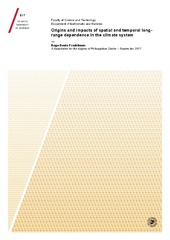Origins and impacts of spatial and temporal long-range dependence in the climate system
Permanent lenke
https://hdl.handle.net/10037/11847Åpne
Thesis (PDF)
Paper I: Fredriksen H.-B., Rypdal, K.: “Spectral characteristics of instrumental and climate model surface temperatures”. Also available in J. Climate 2016, 29:1253–1268. (PDF)
Paper II: Rypdal, K., Rypdal, M., Fredriksen, H.-B.: «Spatiotemporal Long- Range Persistence in Earth’s Temperature Field: Analysis of Stochastic- Diffusive Energy Balance Models”. Also available in J. Climate 2015, 28:8379–8395. (PDF)
Paper III: Fredriksen H.-B., Rypdal, M.: “Long-range persistence in global surface temperatures explained by linear multibox energy balance models”. Also available in J. Climate 2017, 30:7157–7168. (PDF)
Dato
2017-11-27Type
Doctoral thesisDoktorgradsavhandling
Forfatter
Fredriksen, Hege-BeateSammendrag
The internal variability of most Earth surface temperatures has a power spectral density well described by a power law, S(f) ~ f-β, and we typically observe 0 < β < 1. This characterizes variability exhibiting long-range dependence (LRD), which has no characteristic time scale. However, there is no consensus about the physical mechanisms behind this property, and the topic of this thesis is to explore where it comes from.
In Paper I, the spectral characteristics of detrended instrumental temperature records and temperatures simulated in climate models are studied. The persistence, as measured by β, is found to be stronger for sea than for land, and increasing with the degree of spatial averaging. An interpretation of the increase with spatial averaging is that high-frequency variability is averaged out to a larger degree than low-frequency variability. Paper II presents a spatiotemporal model with this property, and more specifically, it predicts that global β is twice the value of the local β on a uniform sphere. For temperatures in observation data and climate models, there are some regional differences in the spectral characteristics, but on average they are consistent with the model.
Paper III demonstrates how LRD in global temperature can be explained by a linear multibox energy balance model (EBM). In linear models, temperatures can be described as a response function convolved with the forcing. For the multibox EBM, the response function consists of a sum of exponential responses, which with the parameters estimated, is well approximated by a power-law response. Only three boxes, implying three response times, are needed to approximate the power-law response on scales from months to centuries. When driven by white noise forcing, a power-law response gives a process exhibiting LRD, which is well approximated by the sum of Ornstein-Uhlenbeck processes obtained for the exponential responses.
This thesis also puts these concepts into the context of simple climate models in general. The findings of multiple and long response times means that we can expect continued responses to past forcing for a long time into the future – longer than predicted from simple models that do not include interaction with the deep ocean.
Forlag
UiT Norges arktiske universitetUiT The Arctic University of Norway
Metadata
Vis full innførselSamlinger
Copyright 2017 The Author(s)
Følgende lisensfil er knyttet til denne innførselen:


 English
English norsk
norsk
